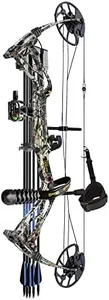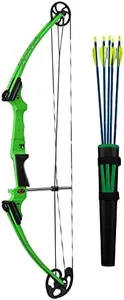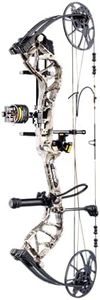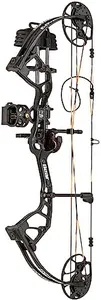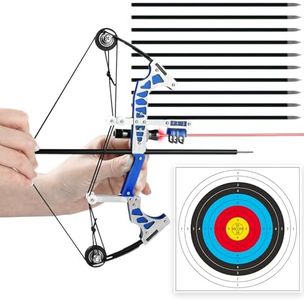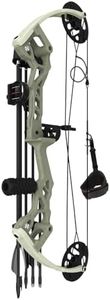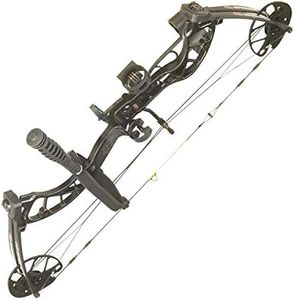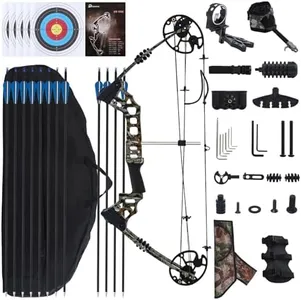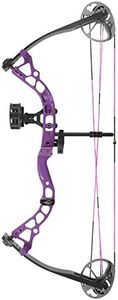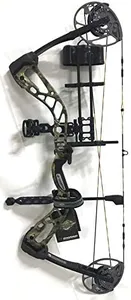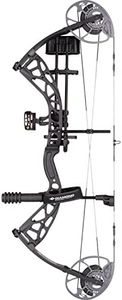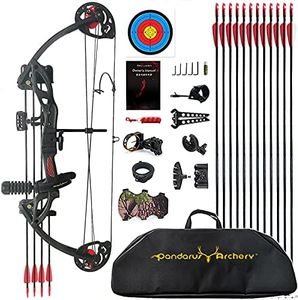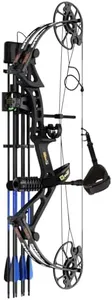10 Best Beginner Compound Bows 2025 in the United States
Our technology thoroughly searches through the online shopping world, reviewing hundreds of sites. We then process and analyze this information, updating in real-time to bring you the latest top-rated products. This way, you always get the best and most current options available.

Our Top Picks
Winner
Sanlida Archery Dragon X8 RTH Compound Bow Package for Adults and Teens,18”-31” Draw Length,0-70 Lbs Weight,up to IBO 310 fps,No Press Needed,Limbs Made in USA,Limited Life-time Warranty
Most important from
2665 reviews
The Sanlida Archery Dragon X8 RTH Compound Bow Package is a solid choice for beginners, adults, and teens looking to get into archery. One of its main advantages is its impressive adjustable draw weight of 0 to 70 lbs and draw length range of 18 to 31 inches, accommodating various users and skill levels without the need for a bow press. This flexibility makes it user-friendly, especially for those just starting out. The bow's speed, reaching up to 310 fps, ensures a decent performance in the field.
The package comes with all the essential accessories, including a 5-pin sight, arrow rest, and a quiver, making it a comprehensive starter kit. Additionally, the limited lifetime warranty on main parts gives peace of mind to users regarding future maintenance or repairs.
There are some considerations to keep in mind. The weight of 3.8 lbs is on the heavier side for a beginner's bow, which may be tiring for extended use. Furthermore, while the materials used are of good quality, the durability of accessories included can vary, and some users may need to invest in higher-quality replacements over time. It's also worth noting that, although the bow is designed for beginners, mastering the various settings and adjustments may take some time.
The Sanlida Archery Dragon X8 is a versatile compound bow that can effectively support beginners in their archery journey, thanks to its adjustable specifications and inclusive package. Just be aware of its weight and the potential need for accessory upgrades as you progress.
Most important from
2665 reviews
Genesis Original Lightweight Archery Compound Bow and Arrow Set, Draw Hand - Right, Green
The Genesis Original Lightweight Archery Compound Bow and Arrow Set is a versatile choice for beginners, including children and adults alike. Its adjustable draw length range of 15-30 inches and draw weight of 10 to 20 pounds make it suitable for a wide range of users. This adaptability ensures that individuals of various sizes and skill levels can comfortably use the bow.
The single cam design is advantageous because it eliminates tuning problems, reduces recoil, increases accuracy, and minimizes noise, making the archery experience more enjoyable and less intimidating for beginners. The bow comes pre-assembled with a machined 6061-T6 aluminum riser, sturdy composite limbs, and high-strength bowstrings, ensuring durability and reliability.
Additionally, the bow kit includes useful accessories such as a belt tube quiver, adjustable arm guard, and 5 premium aluminum arrows, enhancing the value and making it a comprehensive starter package. On the downside, the bow's color is limited to green, which might not appeal to everyone. Also, being designed for right-handed users may exclude left-handed beginners. Despite these minor drawbacks, if you're looking for an easy-to-use, versatile, and durable compound bow to kickstart your archery journey, this set is a great option.
Bear Legit Maxx Ready to Hunt Compound Archery Bow, 70lb. Draw Weight, Right Hand, Veil Whitetail/Black
The Bear Legit Maxx Ready to Hunt Compound Archery Bow is a solid option for beginner archers. With a versatile draw weight range from 10 to 70 pounds, it accommodates a wide variety of users, making it great for those just starting out as well as those who want to progress over time. The adjustable draw length from 14 to 30 inches ensures a customizable fit for different arm lengths and shooting styles.
The 31-inch axle-to-axle length and 6.25-inch brace height offer a balanced combination of stability and maneuverability, suitable for a range of shooting conditions. The improved dual cam system provides consistent performance, which is crucial for developing accuracy and confidence in shooting. Additionally, the bow comes with essential accessories like the IMS V-Biscuit rest, Picatinny-mounted Fatal 4 sight, 5 Spot arrow quiver, Snubnose stabilizer, Radical peep sight, and wrist sling, making it ready to use straight out of the box.
On the downside, the bow's weight of 6.95 pounds might be a bit heavy for younger users or those with less arm strength, potentially affecting ease of use and comfort during extended sessions. The quality of materials is robust, with aluminum construction ensuring durability. This bow presents a comprehensive package for beginners looking to start their archery journey, combining versatility, ease of use, and included accessories to ensure a smooth introduction to the sport.
Buying Guide for the Best Beginner Compound Bows
Choosing the right beginner compound bow can be a rewarding experience, but it requires some understanding of the key specifications to ensure you get the best fit for your needs. Compound bows are designed with a system of pulleys and cables to make drawing the bow easier and more efficient. When selecting a beginner compound bow, it's important to consider factors such as draw weight, draw length, axle-to-axle length, brace height, and let-off. These specifications will affect your comfort, accuracy, and overall experience with the bow. Let's break down these key specs to help you make an informed decision.FAQ
Most Popular Categories Right Now
